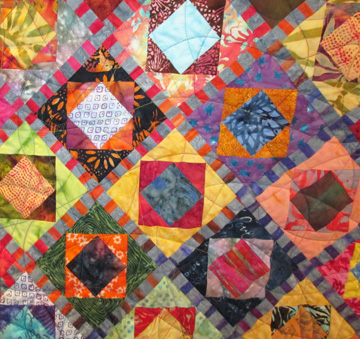Ragtime,
Kaw Valley Quilters Guild,
The Sewhatevers.
Quilted by Lori Kukuk
2013
I'm showing you our guild fundraiser because it's going to some lucky new owner soon.
The Sewhatevers volunteered to make this year's quilt.
We started with a square in a square in a square.
Sarah's been working with this block and just basic color for awhile.
The pattern is BlockBase number 2376 and has been published with several names over the years.
The Ladies' Art Company called it "Hour Glass" about 1900.
Carrie Hall called it "Economy Patch" in 1935.
The Kansas City Star published it as "This and That" in 1944.
and about the same time Nancy Cabot in the Chicago Tribune called it "Thrift Block."
We ignored the thrifty implications of those old names and bought a whole bunch of new fabric in batik style, hand-dyes and prints that look like hand-dyes.
We made a lot of 6-inch blocks, paper-piecing them over foundations.
I'm using the editorial we here. My job was pulling out the paper.
Sarah Fayman's version was our inspiration.
Here's our first idea for a set: Set it side-by-side just like Sarah's. But we realized that joining so many blocks by so many different stitchers makes lining up the points and corners problematic. Sarah's works because she sewed all the blocks herself (and because she is a great stitcher.)
We'd be better off with a sashing to separate all those points.
The color experts picked a stripe, a new-fashioned rainbow type of print and we placed the blocks on point.
Here's a detail
We called it Ragtime and donated it to the Kaw Valley Quilt Guild as a programming fundraiser.
A name will be drawn out of a hat at our annual retreat on September 16, 2013.
If you'd like your name in that hat we'd be glad to take your money.
Email Liz and she will tell you how this quilt could be yours.
Tell her you are interested in the Ragtime Quilt.




























QDBDg~~60_12.jpg)







































